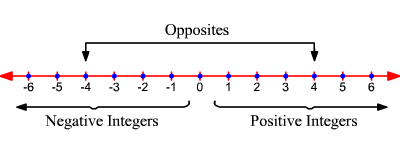Integers
The integers are the set of whole numbers and their opposites. Fractions and decimals are not included in the set of integers.
For example, and are all integers.
The numbers such as and are not integers.
(Note that a number can be an integer even if it is written as a decimal or a fraction: for example, and are both integers, because they are equal to and , respectively.)
The set of integers is usually represented by the symbol .
We can plot the integers as equally spaced points on a number line , as shown in the figure. The arrows at the left and right sides show that the integers continue forever in both directions.

The whole numbers greater than are called positive integers . Their opposites, which are less than , are called negative integers . Zero is neither positive nor negative.
If two numbers are opposite, they are the same distance away from zero. For example, and are opposites, and each is units from zero.
The sum, difference, or product of two integers is an integer. For example,
Sum:
Difference:
Product:
The quotient of two integers is not always an integer.
For example, is an integer because it divides evenly.
However, is not an integer. When a quotient of integers does not divide evenly, the result is a fraction .
Example:
Which of the following numbers is an integer?
is greater than the integer and less than the integer . The at the end of the number indicates a fractional part. So, this is not an integer.
The number has a square root sign; its value is greater than the integer but less than the integer . Since is not a perfect square like or , is not an integer.
The number is a fraction greater than but less than , so this is not an integer.
The number is in the set .
So, is an integer.



